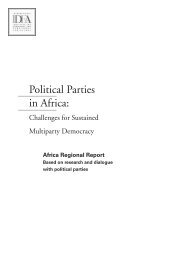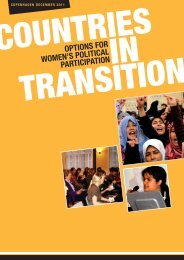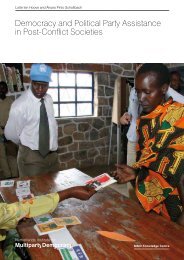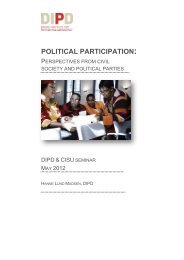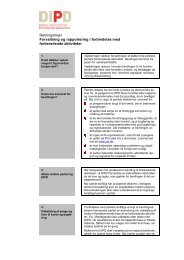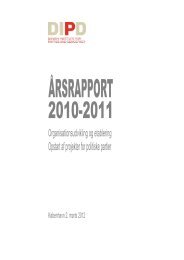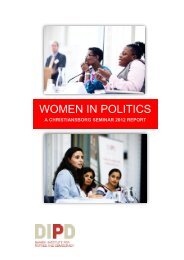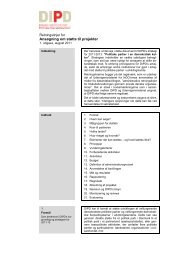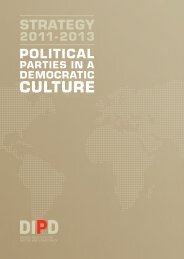Background Document - Danish Institute for Parties and Democracy
Background Document - Danish Institute for Parties and Democracy
Background Document - Danish Institute for Parties and Democracy
You also want an ePaper? Increase the reach of your titles
YUMPU automatically turns print PDFs into web optimized ePapers that Google loves.
THE DANISH PROCESS OF DEMOCRATISATION<br />
The <strong>Danish</strong> success is greatest on the national level. Women have found it harder to<br />
break into local politics, where historical male dominance has survived, notably on<br />
the leadership level. Women hold around thirty per cent of the seats on municipal<br />
councils, <strong>and</strong> there is only one female mayor in ten.<br />
Achieving this success has been a lengthy process. It took seventy years from the<br />
time women’s suffrage was instituted until female politicians made up a so-called<br />
critical mass of thirty per cent, which any minority generally speaking must achieve<br />
in order to obtain real influence.<br />
In Denmark, as everywhere else in the world, women’s political history is an integrated<br />
part of the national development towards democracy. And in Denmark, as<br />
in other Western countries, the women’s movement has been a central player in the<br />
struggles <strong>for</strong> political rights <strong>and</strong>, subsequently, <strong>for</strong> political representation.<br />
Over the course of the nineteenth century, Denmark – initially bringing up the<br />
rear of the democratic transition that created the modern Western world around the<br />
year 1800 – became a pioneer democracy when the Sc<strong>and</strong>inavian welfare model became<br />
an international br<strong>and</strong>. The model – based on equality of status <strong>and</strong> notably<br />
characterised by a high degree of inclusion of women on the labour market, <strong>and</strong> a high<br />
degree of female political representation combined with public child care policies <strong>and</strong><br />
care <strong>for</strong> the sick <strong>and</strong> the elderly – has been labelled as woman-friendly.<br />
The history of democracy in Denmark is thoroughly evolutionary <strong>and</strong> remarkably<br />
undramatic. The country’s first free Constitution, from 1849, had been carefully prepared,<br />
<strong>and</strong> was adopted in the atmosphere of broad consensus that still characterises<br />
political life. Thus, the absolute monarch remained as constitutional monarch following<br />
adoption of the Constitutional Act, <strong>and</strong> today, Denmark is one of only a h<strong>and</strong>ful of<br />
democratic monarchies in the world.<br />
“ The history of democracy in Denmark is<br />
evolutionary <strong>and</strong> remarkably undramatic.“<br />
<strong>Danish</strong> democracy was imported from abroad. Following the uprising against British<br />
colonial rule in North America <strong>and</strong> the founding of the United States of America as<br />
an independent nation in 1776, a flood of revolutions swept over Europe in three separate<br />
waves. The two first waves did not reach Denmark with enough <strong>for</strong>ce to overthrow<br />
the absolute monarchy, but they initiated a much-needed process of modernisation.<br />
During the time of the French Revolution (1789-99), a series of comprehensive<br />
l<strong>and</strong> <strong>and</strong> educational re<strong>for</strong>ms were carried out in Denmark. Farmers were released<br />
from servitude under the l<strong>and</strong>ed aristocracy <strong>and</strong> were granted the opportunity to buy<br />
the l<strong>and</strong> they farmed. During this period, the establishment of teacher training colleges<br />
brought improvements to education, which, particularly in rural areas, had been<br />
of a meagre st<strong>and</strong>ard. Compulsory general education was instituted in 1814.<br />
The July Revolution of 1830 led to cautious democratisation through the establishment<br />
of elected regional councils – the so-called Advisory Provincial Estates – <strong>and</strong><br />
the fledgling beginnings of municipal government. Only a few per cent of the male<br />
population were eligible to vote, but in the years leading up to 1848 the new political<br />
arenas, along with the easing of censorship <strong>and</strong> a modern press, created a bourgeois<br />
public sphere. Knowledge of international developments was no longer the privilege<br />
of a tiny academic elite that was in comm<strong>and</strong> of the major European languages <strong>and</strong><br />
undertook educational journeys to the centres of culture. Broad swathes of the pop-<br />
WOMEN IN POLITICS DANISH INSTITUTE FOR PARTIES AND DEMOCRACY PAGE 46



